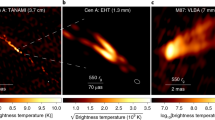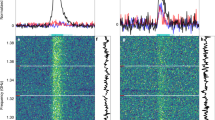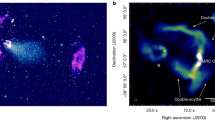Abstract
THE radio source 3C273 was one of the first to be identified1 with a QSO. The main features of the brightness distribution have been established from lunar occupation studies2–5, which show that the source is double, with one component coincident with a 13 mag QSO or redshift 0.158. This component, 3C273B, is variable, and has an inverted radio spectrum. The component is compact, and details of its structure have been investigated with inter-continental (VLBI) interferometers6–8. The other component, 3C273A, has a normal radio spectrum and is identified with a faint optical jet lying in position angle 223° with respect to the QSO. Component A has extended radio structure, and is not detected in VLBI observations8. The colours of the jet indicate that the optical emission, like the radio emission from component A, is non-thermal9,10. The optical jet of 3C273 is an extremely unusual feature, and it would be interesting to make a detailed comparison of the optical and radio structure associated with the component. We provide here detailed information of the radio brightness distribution.
This is a preview of subscription content, access via your institution
Access options
Subscribe to this journal
Receive 51 print issues and online access
$199.00 per year
only $3.90 per issue
Buy this article
- Purchase on Springer Link
- Instant access to full article PDF
Prices may be subject to local taxes which are calculated during checkout
Similar content being viewed by others
References
Hazard, C., Mackey, M. B., and Shimmins, A. J., Nature, 197, 1037–1039 (1963).
Hughes, M. P., Nature, 207, 178–179 (1965).
van Hoerner, S., Astrophys. J., 144, 483–495 (1966).
Hazard, C., Gulkis, S., and Bray, A. D., Nature, 210, 888–891 (1966).
Hazard, C. et al., Nature phys. Sci., 233, 89–91 (1971).
Kellermann, K. I. et al., Astrophys. J., 169, 1–24 (1971).
Rogers, A. E. E. et al., Astrophys. J., 193, 239–301 (1974).
Clarke, R. W., Broten, N. W., Legg, T. H., Locke, J. L., and Yen, J. L., Mon. Not. R. astr. Soc., 146, 381–397 (1969).
Schmidt, M., Nature, 197, 1040 (1963).
Kron, G. E., Ables, H. D., and Hewitt, A. V., Publs astr. Soc. Pacific., 84, 303–305 (1972).
Conway, R. G., and Stannard, D., Nature phys. Sci. 239, 22–23 (1972).
Hazard, C., Gulkis, S., and Bray, A. D., Nature, 212, 461–463 (1966).
Hogbom, J. A., Astr. Astrophys. Suppl., 15, 417–426 (1974).
Harris, A., Mon. Not. R. astr. Soc., 166, 449–461 (1974).
Anderson, B., and Donaldson, W., Mon. Not. R. astr. Soc., 137, 81–94 (1967).
Author information
Authors and Affiliations
Rights and permissions
About this article
Cite this article
CONWAY, R., STANNARD, D. Radio brightness distribution of 3C273. Nature 255, 310–312 (1975). https://doi.org/10.1038/255310a0
Received:
Accepted:
Issue Date:
DOI: https://doi.org/10.1038/255310a0
This article is cited by
-
The radio jet of the quasar 3C273
Nature (1985)
-
Radio jet of 3C273
Nature (1981)
-
Superluminal expansion of quasar 3C273
Nature (1981)
-
Twin-jets from the centres of galaxies
Astrophysics and Space Science (1981)
-
Two new D2 QSOs
Nature (1977)
Comments
By submitting a comment you agree to abide by our Terms and Community Guidelines. If you find something abusive or that does not comply with our terms or guidelines please flag it as inappropriate.



